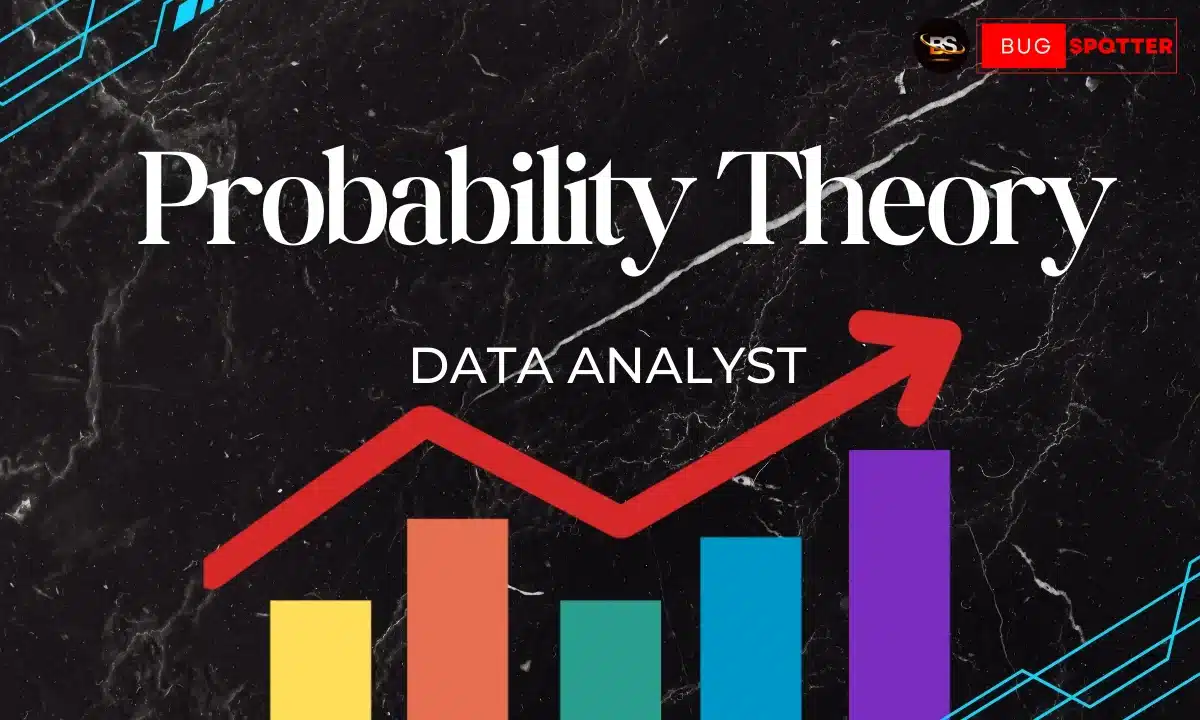Probability Theory

What is Probability Theory?
In the simplest terms, probability theory is a branch of mathematics that deals with calculating the likelihood of events happening. It provides a foundation for understanding uncertainty and variability, which is fundamental when dealing with real-world data.
In data analysis, probability helps us make predictions, assess risks, and uncover patterns within data sets. It allows analysts to measure the likelihood of outcomes based on available information, which is especially important when working with incomplete or noisy data.
Why Does Probability Matter in Data Analysis?
Data is rarely perfect or complete. There are always uncertainties involved, whether it’s due to noise in the data, sampling errors, or missing values. Probability theory helps analysts deal with this uncertainty and make sense of the data.
For example, in business, understanding the probability of certain customer behaviors (like purchasing a product) can help companies forecast sales, optimize marketing strategies, and make better business decisions.
Here’s how probability is crucial in different stages of data analysis:
- Exploratory Data Analysis (EDA):
- EDA involves understanding the data, detecting patterns, and spotting anomalies. Probability helps analysts estimate the likelihood of certain patterns emerging.
- Statistical Inference:
- When we make conclusions or predictions based on sample data, we use probability to quantify the uncertainty in our results. For instance, we use confidence intervals to estimate population parameters and hypothesis testing to check the validity of assumptions.
- Predictive Modeling:
- Probability underpins machine learning algorithms, especially in classification and regression models. Many algorithms (like Naive Bayes) are directly built on probabilistic principles.
Key Concepts in Probability Theory
Let’s break down some foundational concepts that form the backbone of probability theory:
1. Random Variables
- A random variable is a variable whose values depend on the outcomes of a random phenomenon. In data analysis, this could represent anything from customer behavior to stock prices.
- Random variables can be discrete (e.g., the number of defective items in a batch) or continuous (e.g., the height of people in a population).
2. Probability Distribution
- A probability distribution defines how the probabilities are distributed over the values of a random variable. There are several types of distributions:
- Discrete Probability Distribution (e.g., Binomial, Poisson)
- Continuous Probability Distribution (e.g., Normal, Exponential)
- These distributions help us model real-world data and estimate the probability of different outcomes.
3. Bayes’ Theorem
- Bayes’ Theorem is a powerful concept in probability that updates the probability of a hypothesis based on new evidence. It’s particularly useful in data analysis for updating predictions as new data comes in. For example, it forms the basis of Bayesian Inference, which is widely used in statistical modeling and machine learning.
4. Expected Value and Variance
- The expected value (mean) of a random variable represents the long-term average or central tendency.
- The variance measures how spread out the values of a random variable are from the mean. Both of these metrics are essential in understanding data behavior, especially in risk analysis.
5. Conditional Probability
- Conditional probability is the probability of an event happening given that another event has occurred. This concept is critical in situations where events are dependent on each other, such as predicting customer behavior based on past purchases.
6. Markov Chains and Stochastic Processes
- A Markov Chain is a sequence of events where the probability of each event depends only on the state of the previous event. Markov models are widely used in predictive analytics, especially for time series forecasting and recommendation systems.
- Stochastic processes model systems that evolve over time with inherent randomness. They are essential in fields like finance (modeling stock prices), biology (predicting population growth), and machine learning.
7. Law of Large Numbers and Central Limit Theorem
- The Law of Large Numbers states that as the sample size grows, the sample mean will converge to the population mean. This principle is crucial for ensuring the reliability of data analysis and predictive models.
- The Central Limit Theorem is one of the most important results in probability theory. It states that for a large enough sample, the distribution of the sample mean will approximate a normal distribution, regardless of the original data distribution. This theorem underpins statistical inference methods and hypothesis testing.
8. Maximum Likelihood Estimation (MLE)
- Maximum Likelihood Estimation is a method used to estimate the parameters of a probability distribution or model that maximize the likelihood of observing the given data. It is fundamental in parameter estimation for statistical models and machine learning algorithms.
9. Entropy and Information Theory
- Entropy is a measure of uncertainty or randomness in a system. In information theory, entropy quantifies the amount of information in a data set. This is important in areas such as data compression and decision tree algorithms.
- Shannon entropy is used in machine learning, especially in decision tree algorithms (like ID3 or C4.5), where entropy measures the unpredictability or impurity in the data, helping to decide the best split in the tree-building process.
10. Simulations and Monte Carlo Methods
- Monte Carlo simulations use random sampling to solve problems that may be deterministic in nature but involve uncertainty. This method is particularly useful when you cannot analytically solve a problem or when you want to estimate complex integrals or probability distributions.
- Simulations are widely used in finance, risk analysis, and various other fields where uncertainty is present.
Advantages of Using Probability in Data Analysis
Now that we’ve explored the foundational aspects of probability theory, let’s look at the advantages of incorporating probability into data analysis:
1. Handling Uncertainty and Variability
- Advantage: Real-world data is often noisy and incomplete. Probability theory provides tools to manage and quantify uncertainty, helping analysts and decision-makers make informed decisions despite the randomness in data.
- Example: When predicting customer churn, probability helps quantify how likely a customer is to leave based on various factors, even if those factors are uncertain.
2. Better Decision-Making
- Advantage: Probability allows data analysts to assess risks and weigh potential outcomes, leading to more effective decision-making.
- Example: In finance, probability models help investors understand the risk associated with different portfolios, aiding them in making decisions that align with their risk tolerance.
3. Improved Prediction Accuracy
- Advantage: By incorporating probabilistic models into predictive analytics, you can generate more accurate forecasts. These models account for variability and potential future uncertainties.
- Example: In stock market prediction, probability theory helps model future price movements and generate probabilistic forecasts, improving the accuracy of investment strategies.
4. Optimized Resource Allocation
- Advantage: Probability theory aids in determining the likelihood of various scenarios, enabling businesses and organizations to allocate resources more efficiently and prioritize actions based on likely outcomes.
- Example: In supply chain management, probability can help forecast demand variability and optimize inventory levels to avoid overstocking or understocking.
5. Statistical Significance and Confidence
- Advantage: Probability plays a vital role in hypothesis testing and statistical significance, ensuring that results are not due to random chance. This increases the reliability of conclusions drawn from data.
- Example: In A/B testing, probability is used to evaluate whether the difference between two variations is statistically significant, helping businesses make data-driven decisions.
6. Supports Complex Models
- Advantage: Many advanced machine learning algorithms are based on probabilistic principles. Probability theory allows for the development and application of these models, making it easier to work with complex systems.
- Example: In natural language processing (NLP), probabilistic models like Hidden Markov Models (HMMs) are used for tasks such as speech recognition and part-of-speech tagging.
Probability in Action: How It Powers Data Analysis
Let’s look at a few practical scenarios where probability theory plays a crucial role:
1. Predictive Modeling with Logistic Regression
- Logistic regression, a widely used algorithm for binary classification, is built on the concept of probability. The model predicts the probability that an observation belongs to a particular class (e.g., customer will buy a product or not). This is a direct application of probability theory to understand the likelihood of an event.
2. Risk Assessment
- In financial analysis, probability is used to assess risk and make informed decisions. For example, the probability of a stock’s price increasing can be modeled using historical data and probability distributions, helping investors make better investment choices.
3. A/B Testing and Hypothesis Testing
- A/B testing relies heavily on probability theory to determine the statistical significance of experimental results. By using hypothesis testing, analysts can evaluate the likelihood that an observed difference in data is due to a real effect, rather than random chance.
4. Time Series Forecasting
- When predicting future values based on historical data (such as sales forecasting), probability models like Markov Chains or ARIMA (AutoRegressive Integrated Moving Average) are used to estimate the likelihood of future outcomes, considering trends and seasonality in the data.
5. Anomaly Detection
- Anomaly detection techniques often rely on probability distributions to identify outliers or unusual patterns in the data. For example, a Gaussian Mixture Model (GMM) uses a combination of multiple normal distributions to model data and detect anomalies based on the probability of certain data points fitting within the modeled distribution.
Real-World Applications of Probability in Data Analysis
- Healthcare: Predicting the likelihood of a patient developing a condition based on their medical history, genetics, and lifestyle.
- Marketing: Estimating the probability that a customer will click on an ad or purchase a product based on past behavior.
- E-commerce: Personalizing recommendations using probabilistic models to predict what products a customer is likely to buy next.
- Sports Analytics: Using probability to forecast outcomes of games, player performance, and team strategies.
- Supply Chain Optimization: Applying probabilistic models to forecast demand and manage inventory more efficiently.
Latest Posts
- All Posts
- Software Testing
- Uncategorized





Categories
- Artificial Intelligence (5)
- Best IT Training Institute Pune (9)
- Cloud (2)
- Data Analyst (55)
- Data Analyst Pro (15)
- data engineer (18)
- Data Science (104)
- Data Science Pro (20)
- Data Science Questions (6)
- Digital Marketing (4)
- Full Stack Development (7)
- Hiring News (41)
- HR (3)
- Jobs (3)
- News (1)
- Placements (2)
- SAM (4)
- Software Testing (70)
- Software Testing Pro (8)
- Uncategorized (33)
- Update (33)
Tags
- Artificial Intelligence (5)
- Best IT Training Institute Pune (9)
- Cloud (2)
- Data Analyst (55)
- Data Analyst Pro (15)
- data engineer (18)
- Data Science (104)
- Data Science Pro (20)
- Data Science Questions (6)
- Digital Marketing (4)
- Full Stack Development (7)
- Hiring News (41)
- HR (3)
- Jobs (3)
- News (1)
- Placements (2)
- SAM (4)
- Software Testing (70)
- Software Testing Pro (8)
- Uncategorized (33)
- Update (33)





